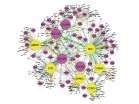(Press-News.org) ATLANTA—A new statistical test that looks at the patterns of high-frequency network activity flow from brain signals can help doctors pinpoint the exact location of seizures occurring in the brain and make surgery more effective, according to researchers at Georgia State University and Emory University School of Medicine. The findings are published in the journal Epilepsia.
Emory researchers Dr. Charles Epstein, Dr. Robert Gross and Dr. Jon Willie; Dr. Bhim Adhikari, a post doctoral researcher at Georgia State, and Dr. Mukesh Dhamala, an associate professor of physics and neuroscience at Georgia State, studied two groups of patients suffering from epileptic seizures, two patients who were awaiting surgery and eight who had already undergone surgery to eliminate their seizures.
The statistical test known as Granger causality spectral analysis was installed in a computer program, and the researchers found they were able to pinpoint where seizures were originating in the brain and detect seizures up to 10 seconds earlier than previously possible.
"Because of a serious deficit in our fundamental understanding of seizure sources and propagation pathways in the brain, there's about a 50 percent cure rate," Dhamala said. "Identifying seizure sources is an imperfect process. Currently, there are no universally established criteria to clinically identify the seizure onset zones useful for successful surgery. So we've tried to contribute to identifying where a seizure comes from so that the doctor can target the mostly likely seizure sources. Without identifying the location, the surgery cannot happen. For the two patients who were going to have surgery, our results helped to identify the locations of their seizures and eliminate some suspected locations for the doctors to operate."
A seizure is an abnormal, uncontrollable electrical discharge in the brain that produces changes in awareness, sensations and motor behaviors. More than 50 million people worldwide and 2.5 million people in the United States suffer from epileptic seizures. Thirty percent of these cases don't respond to medication, making surgery in which a doctor removes the part of the brain where the seizures originate the only option, Dhamala said.
To identify precisely where seizures are coming from, a person is hospitalized, his or her skull is opened and electrodes are implanted in the brain so electrical activity can be monitored when a seizure occurs.
For the two patients in the study awaiting surgery, the researchers used Granger causality analysis to evaluate intracranial EEG (iEEG) recordings of the patients' brains, locate the seizures and determine which parts of the brain are not the sources of the seizures.
For the eight post-surgery patients, this analysis was not applied for surgical decision-making. The researchers analyzed iEEG recordings taken before surgery to determine if the correct part of the brain was removed. Two of the patients suffered relapses and weren't free of seizures, and the research team concluded the part of the brain that was removed during surgery was inconsistent with their statistical findings about which part was causing the seizures. The researchers identified where the seizures were originating, and doctors were able to prescribe medication to manage the seizures. Both patients improved and remain seizure-free one year later.
The team chose to use Granger causality analysis because it can be applied to any network phenomena that have time series recordings from dynamic processes, such as epileptic seizures. A seizure starts in one part of the brain and spreads to other parts. Granger causality can estimate the direction, strength and frequency of information flow among the recording sites.
In the future, the research team would like to make the computer program faster and able to handle larger data sets, which would allow it to assist doctors in real time and be implemented into medical treatment for epileptic patients. They would also like to develop a graphical interface that can show the time series and pattern of causal flow of seizures side by side.
In addition, they would like to understand how high frequency network activity in the brain relates to underlying structural abnormalities. In this study, they showed that high-frequency activity can be detected early and used to predict seizures.
INFORMATION:
This study was supported by a grant from the Brains and Behavior program at Georgia State. The study, "Application of High-Frequency Granger Causality to
Analysis of Epileptic Seizures and Surgical Decision Making," is available online at http://onlinelibrary.wiley.com/journal/10.1111/(ISSN)1528-1167.
Granger causality test can make epilepsy surgery more effective
2014-11-04
ELSE PRESS RELEASES FROM THIS DATE:
Mayo Clinic researchers discover genetic markers for alcoholism recovery
2014-11-04
ROCHESTER, Minn. — In an international study, Mayo Clinic researchers and collaborators have identified genetic markers that may help in identifying individuals who could benefit from the alcoholism treatment drug acamprosate. The findings, published in the journal Translational Psychiatry, show that patients carrying these genetic variants have longer periods of abstinence during the first three months of acamprosate treatment.
Acamprosate is a commonly prescribed drug used to aid patients in recovery from alcoholism. Mayo researchers studied the association between ...
Are there as many rats as people in New York City?
2014-11-04
Urban legend states that New York City has as many rats as people: roughly 8 million; but a new analysis suggests there are nowhere near as many.
The analysis classified rat sightings by city lot, of which there are roughly 842,000 in New York City. The researchers estimated 40,500 rat-inhabited lots in the city. By liberally assuming that 40 to 50 rats belong to a typical colony and that one full colony occupies each rat-inhabited lot, the researchers concluded that 2 million would be an extremely generous estimate of the city's rat population.
"While the rat population ...
Type 2 diabetes, cardiovascular disease may share deep roots
2014-11-04
PROVIDENCE, R.I. [Brown University] — Type 2 diabetes (T2D) and cardiovascular disease (CVD) appear to have a lot in common. They share risk factors such as obesity and they often occur together. If they also share the same genetic underpinings, then doctors could devise a way to treat them together too. With that hope in mind, scientists applied multiple layers of analysis to the genomics of more than 15,000 women. In a new study they report finding eight molecular pathways shared in both diseases as well as several "key driver" genes that appear to orchestrate the ...
Research in the identity of agricultural pests has broad implications
2014-11-04
A global research effort has resolved a major biosecurity issue by determining that four of the world's most destructive agricultural pests are one and the same.
The Oriental fruit fly, the Philippine fruit fly, the Invasive fruit fly, the Carambola fruit fly, and the Asian Papaya fruit fly cause incalculable damage to horticultural industries and food security across Asia, Africa, the Pacific, and parts of South America. More than 40 researchers from 20 countries examined available evidence and determined that the Carambola fruit fly is a distinct species, but the other ...
Many future health professionals drink too much alcohol
2014-11-04
A new study found that 43% of nursing students indulge in hazardous alcohol consumption, with 14.9% of men and 18.7% of women meeting criteria for hazardous drinkers.
Hazardous drinkers were more likely to be young, to smoke, and to live outside the family nucleus.
"Alcohol-prevention activities should envisage greater protection of university settings, particularly where future health professionals are involved," wrote the authors of the Journal of Advanced Nursing study.
INFORMATION:
...
New research explores scent communication in polar bears
2014-11-04
New research indicates that scent associated with polar bear paws conveys information that may affect the animals' social and reproductive behavior. This chemical form of communication was likely shaped by the environmental constraints of Arctic sea ice.
Scientists worry that this communication may be impacted if scent trails are disrupted due to increased fracturing of sea ice from climate change.
"Effective communication is essential for successful reproduction in solitary, wide-ranging animals," said Dr. Megan Owen, lead author of the Journal of Zoology study. "Developing ...
Syracuse geologist reveals correlation between earthquakes, landslides
2014-11-04
A geologist in Syracuse University's College of Arts and Sciences has demonstrated that earthquakes--not climate change, as previously thought--affect the rate of landslides in Peru.
The finding is the subject of an article in Nature Geoscience (Nature Publishing Group, 2014) by Devin McPhillips, a research associate in the Department of Earth Sciences. He co-wrote the article with Paul Bierman, professor of geology at The University of Vermont; and Dylan Rood, a lecturer at Imperial College London (U.K.).
"Geologic records of landslide activity offer rare glimpses ...
Ebola may be deadlier and more widespread than we think
2014-11-04
The current Ebola outbreak in West Africa has grown exponentially since May, indicating inadequate global response. A new analysis indicates that the outbreak's fatality rate is over 70%—rather than 50% as previously claimed by the World Health Organization—and that the total number of affected individuals could exceed 1 million by early next year.
As long as the number of infected people rises exponentially, the likelihood of exporting Ebola to other countries does as well.
"The disease itself hasn't changed, with essentially the same fatality rate and ...
Breastfeeding: Shame if you do, shame if you don't
2014-11-04
A new study of 63 women with varied infant feeding experiences reveals that breastfeeding mothers may feel shame if they breastfeed in public due to exposure, while those who do not breastfeed may experience shame through 'failing' to give their infant the 'best start.'
Breastfeeding and non-breastfeeding mothers may also experience shame through inadequate support, judgment, and condemnation, leading to feelings of failure, inadequacy, and isolation.
"This study highlights the difficulties and tensions that breastfeeding and non-breastfeeding women can face in hospital ...
Radiation a risk factor for brain tumors in young people
2014-11-04
In people under age 30, radiation is a risk factor for a type of brain tumor called a meningioma, a Loyola University Medical Center study has found.
Researchers analyzed records of 35 patients who were diagnosed with meningiomas before age 30. Five had been exposed to ionizing radiation earlier in their lives. They include two patients who received radiation for leukemia at ages 5 and 6; one who received radiation at age 3 for a brain tumor known as a medulloblastoma; and one who received radiation for an earlier skull base tumor that appeared to be a meningioma. The ...

